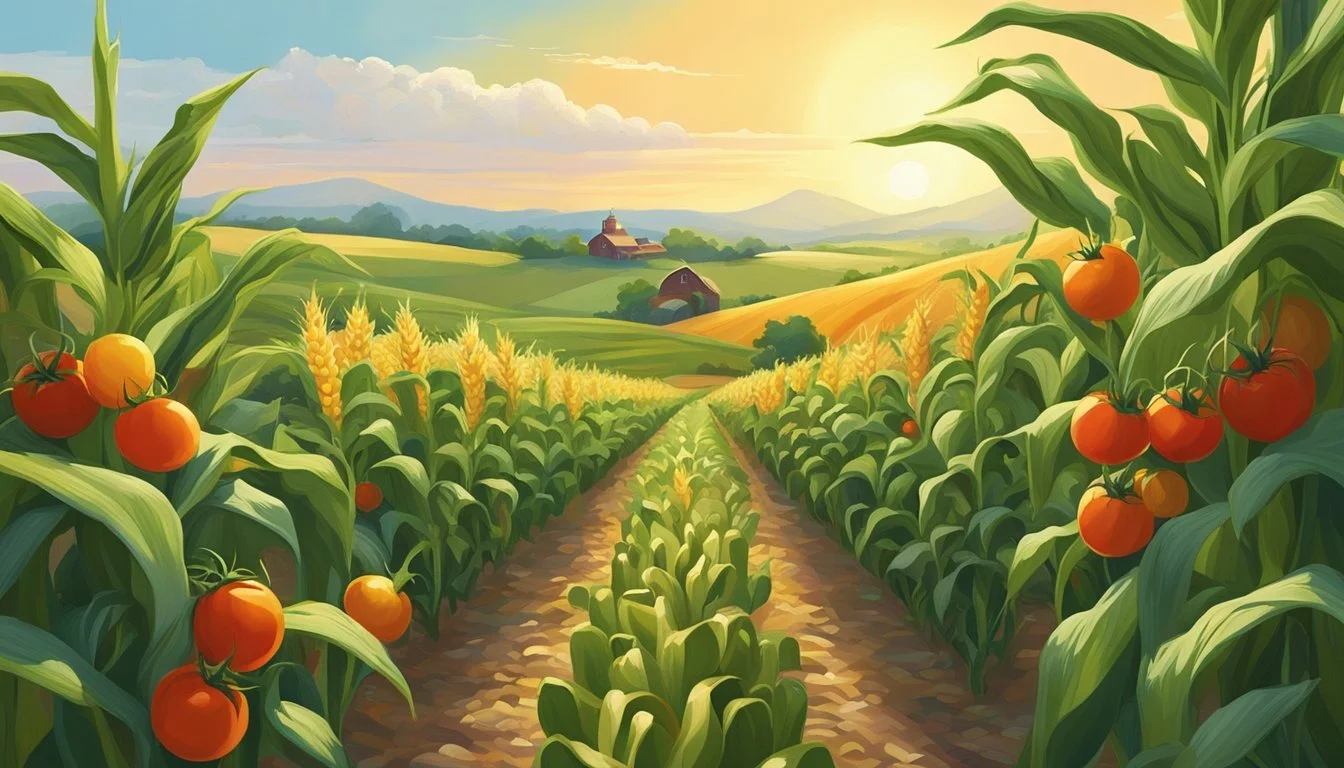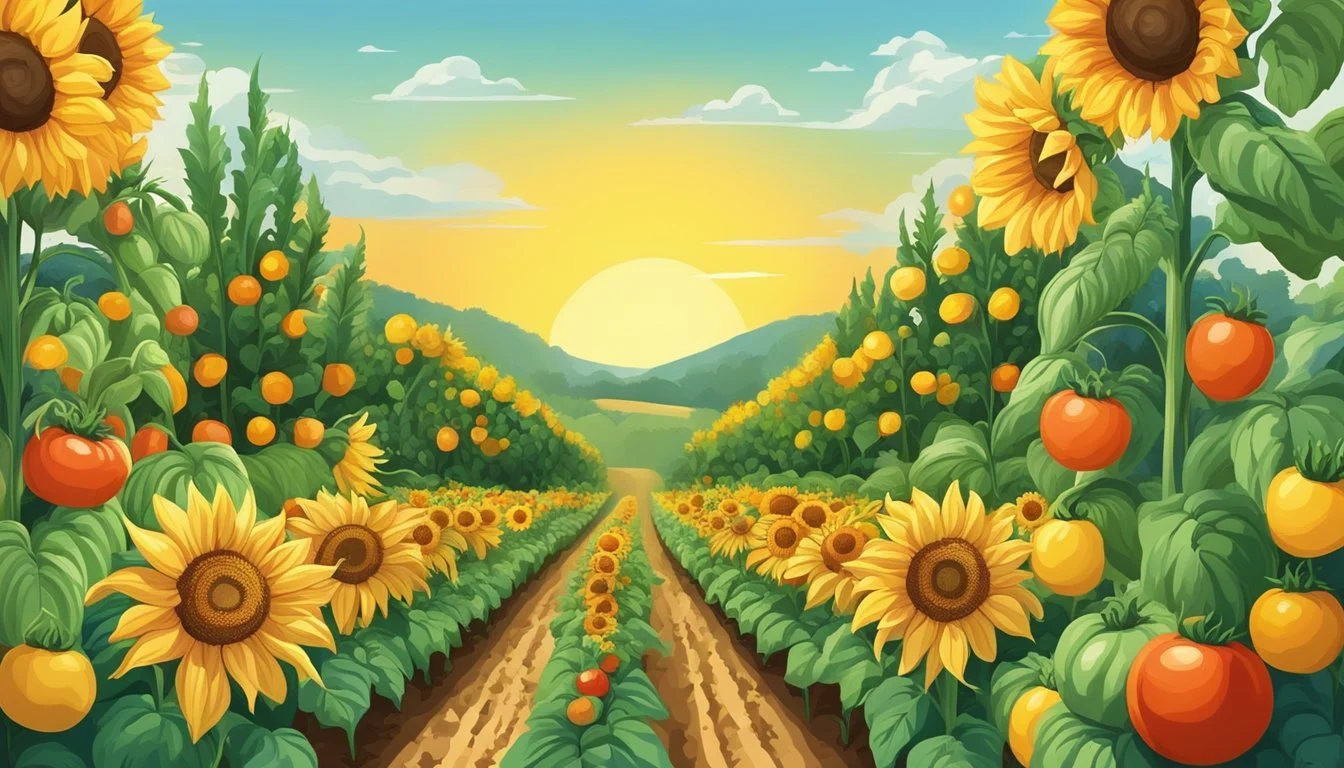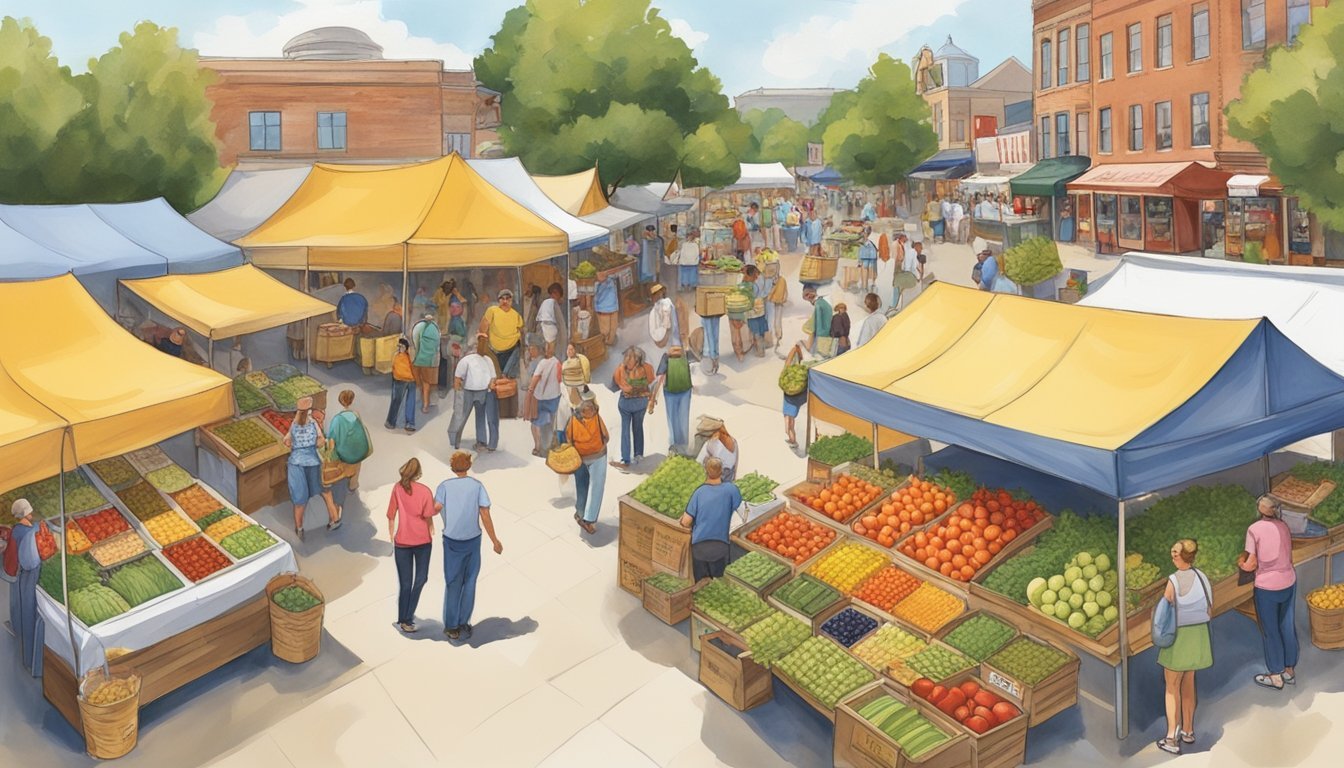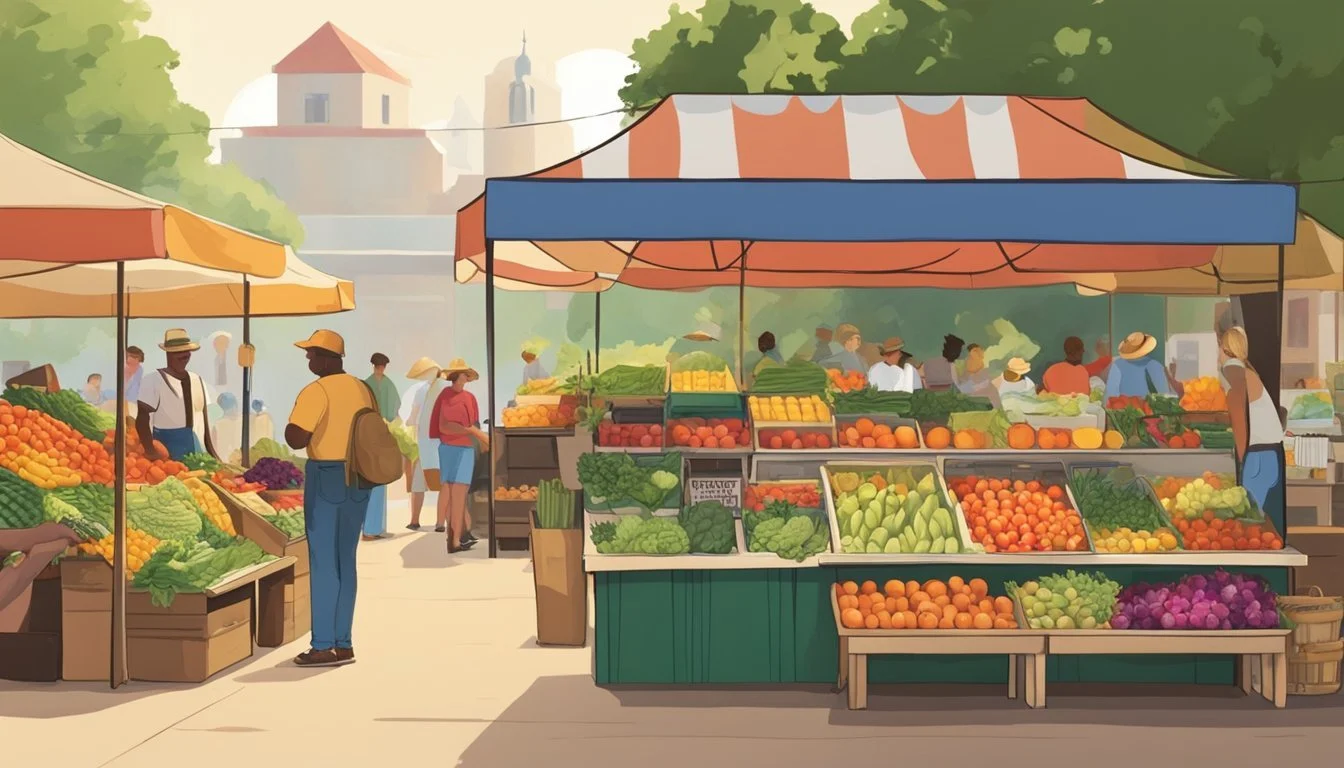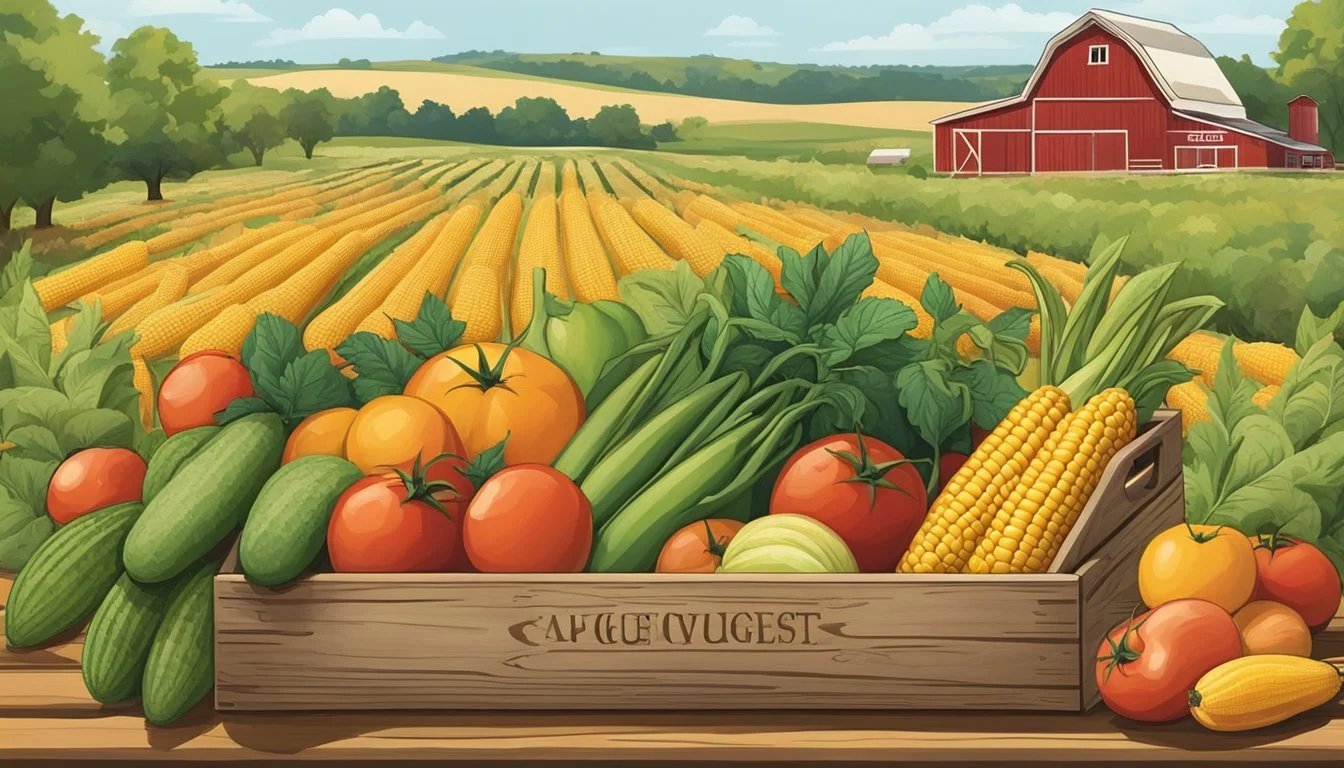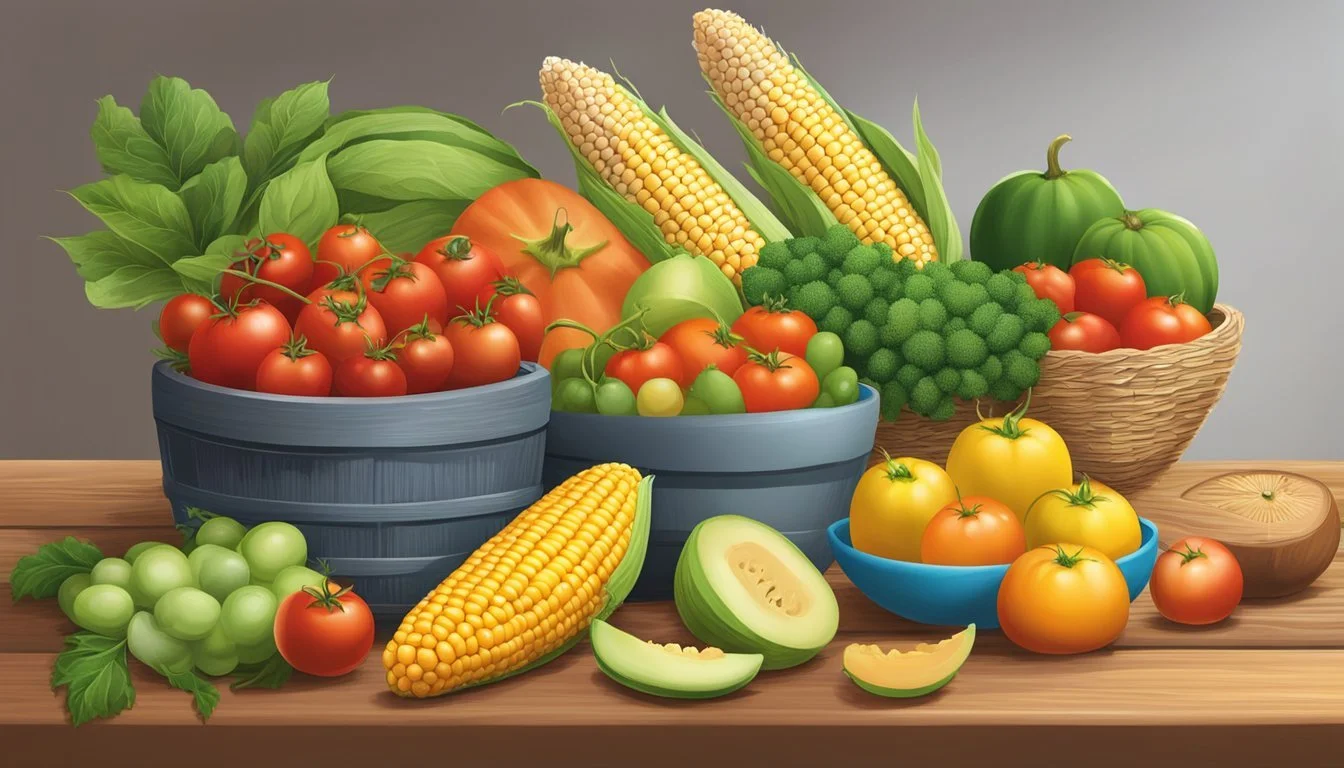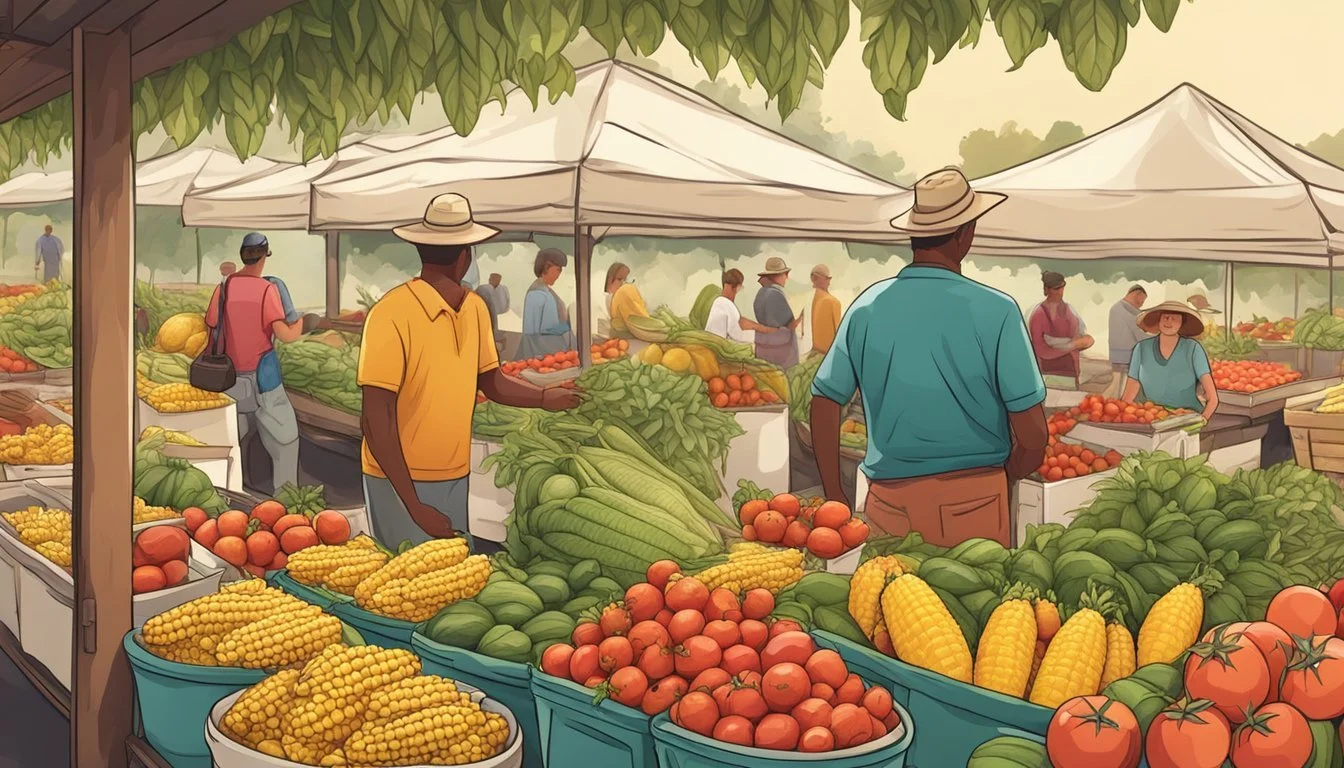Iowa Seasonal Fruit & Vegetables in August
A Fresh Guide to Local Produce
This Article is Part of our Iowa Seasonal Fruit & Veg Calendar
August in Iowa marks the transition from the heart of summer into the early whispers of fall. This period is ripe with a bounty of fresh fruit and vegetables, with local produce at its peak of flavor and nutritional value. Farmers' markets and grocery stores throughout the state brim with colorful, freshly-harvested produce, making it an ideal time for consumers to enjoy the fruits of the season.
During this time, the warm Iowa climate cultivates an abundant variety of seasonal offerings. Sweet corn (how long does corn last?) and tomatoes are staples in August, with their harvests offering some of the juiciest and most flavorful options of the year. Melons, especially cantaloupes (how long does cantaloupe last?) and watermelons, reach their full ripeness, providing a refreshing treat during the summer heat.
Beyond these favorites, the state's rich soil also supports a diverse range of other fruits and vegetables including peppers, cucumbers (how long do cucumbers last?), and zucchini. Berries, like blackberries (how long do blackberries last?), are also in their prime, perfect for fresh eating or for use in a multitude of recipes, from pies to jams. Iowa's August harvest is an opportunity for consumers to savor the local flavors and to support the regional agricultural community.
Iowa's Growing Season
In Iowa, the warm summer months extend the growing season and bring an abundance of fresh produce to cultivation. By August, the state is at its peak for producing some of the freshest and most flavorful fruits and vegetables. Farmers and gardeners alike benefit from the long days and rich soil, fostering optimal growth for a diverse range of crops.
Seasonal Highlights: During this time, a selection of fruits and vegetables come into their prime, ensuring quality and taste are at their best. Cantaloupes and watermelons are notably ripe, with their refreshing qualities being a staple at summer gatherings. Sweet corn, an Iowa hallmark, is also harvested during this period, and its freshness is unrivaled, often going from stalk to table within the same day.
Vegetable Harvest:
Tomatoes
Green beans
Zucchini
Cucumbers
Bell peppers
These vegetables are particularly in season, and one can find them at local markets and roadside stands, bursting with freshness.
Fruit Ripeness: Fruits like peaches and blueberries (how long do blueberries last?) may still be found in August, although their peak seasons are typically earlier in the summer.
Iowa's agricultural success is attributed to its climate and soil conditions, which are conducive to growing a variety of crops. Farmers adjust planting schedules to ensure a continual harvest, often staggering plantings throughout the optimal windows. This strategy allows for an extended supply of fresh produce throughout summer and into early fall, making August a time of abundance in Iowa's agricultural calendar.
Seasonal Vegetables in August
In Iowa, the month of August is bountiful, with a variety of vegetables reaching maturity and optimal flavor. Among these, corn stands as a cornerstone of local agriculture, offering its sweetest kernels. Tomatoes and peppers also thrive during this time, presenting an array of colors and tastes ideal for fresh salads or making salsa.
Summer Squash and Zucchini: Versatile in dishes, they are best when harvested while still tender.
Cucumbers: Essential for a refreshing crunch in salads, they're at their peak crispness now.
Green Beans: These can be enjoyed fresh, canned, or frozen, maintaining their pleasant snap.
Eggplants (What wine goes well with eggplant?): With a meaty texture, they are excellent for grilling or as a staple in hearty recipes.
Chard and Kale: Leafy greens that offer both nutrition and flavor continue to grow well during this season.
It is important for consumers to be aware that the actual harvest time can fluctuate due to weather conditions and farm locations. However, these vegetables are generally ready for harvesting in August across the state, providing freshness and local flavor to the tables of Iowa residents.
Seasonal Fruits in August
During the month of August in Iowa, a variety of fruits reach their peak, offering a fresh and vibrant taste that is indicative of summer’s bounty. The selection includes a plethora of berries, stone fruits, and melons, each rich in vitamins and antioxidants.
Berries: Blueberries, blackberries, and raspberries are among the popular choices. These small fruits are not only sweet and tangy but also packed with antioxidants and vitamin C.
Blueberries are typically harvested through July but can often still be found fresh in August.
Blackberries hit their stride in this month, perfect for enjoying fresh or in desserts like crisps or salads.
Raspberries, with their delicate structure and intense flavor, are also readily available.
Stone Fruits: August is a prime time for stone fruits, with peaches standing out both in terms of flavor and nutrition.
Peaches are juicy and versatile, suited to both sweet and savory dishes. They often arrive in markets by mid-summer and continue through August.
Melons: This category includes favorites like watermelon and cantaloupe, which embody the essence of summer hydration and taste.
Watermelons are large and refreshing, offering a cool reprieve from the late-summer heat.
Cantaloupes provide a sweet, musky flavor and are typically at their best towards the later part of the season.
Both melons are not only delicious but also contain a high water content, which can help with hydration during hot August days.
It should be noted that while cherries and strawberries are synonymous with summer fruits, their season in Iowa typically concludes prior to August.
Consumers should look for fruit that is firm and unblemished, as these characteristics often indicate better quality and freshness. Shopping for seasonal fruits not only supports local agriculture but also ensures that one is getting the most flavorful produce available.
Harvesting and Storing Tips
To ensure the quality and longevity of Iowa's seasonal produce, one must apply proper harvesting techniques and storage methods. August's bounty offers a wide variety of fruits and vegetables that require specific care to maintain their freshness and nutritional value.
Harvesting Techniques
When harvesting Iowa's August produce like tomatoes, peppers, or green beans, it's crucial to pick them at their peak ripeness. Vegetables should feel firm to the touch, with vibrant colors characteristic of their variety. It is advised to harvest in the morning when the temperature is cooler to reduce stress on the plants. After harvesting, produce should be cooled immediately to preserve quality.
Tomatoes: Harvest when evenly colored and firm, avoiding squeezing to test for ripeness.
Green Beans: Pick when they are firm and before the seeds inside start to bulge.
Storing for Freshness
Proper storage extends the shelf-life of produce while preserving its flavor and nutritional content. Most vegetables and fruits from the August harvest should be stored in the refrigerator, while some, like onions and garlic, should be kept in a cool, dry place.
Refrigerator: Store leafy greens in a plastic bag with a paper towel to absorb excess moisture.
Cool, Dry Place: Keep potatoes and onions in ventilated baskets separate from each other to prevent spoilage.
Preservation Methods
For long-term storage, preservation is essential. Freezing, canning, and making jam are popular methods for extending the life of fruits and vegetables well beyond their picking season.
Freezing: Blanch vegetables before freezing to preserve texture and color.
Canning: Use a pressure canner for low-acid vegetables to ensure safety.
Jam: Fruit high in pectin (how long does pectin last?), like peaches, can be transformed into jam for a year-round treat.
Culinary Uses and Recipes
As the height of summer graces Iowa, the culinary landscape teems with ripe ingredients perfect for creating an array of dishes. Fresh produce like cucumbers, eggplants, and an assortment of peppers become the stars of the season, lending themselves to refreshing salads, hearty main dishes, and sweet desserts.
Salads and Sides
The mild crunch of cucumber works wonderfully in salads and as an accompaniment to meals. One can create a Cucumber Pico de Gallo by combining diced cucumbers, tomatoes, onions, cilantro, lime juice, salt, and peppers for a refreshing side. Peppers bring color and flavor to various dishes; a Mango Salsa made with ripe mangoes, red bell peppers, and a hint of chili can be a sweet and spicy addition to grilled fish or chicken.
Eggplant, with its robust texture, is often featured in side dishes such as Baba Ganoush, a smoky, creamy dip made by blending roasted eggplant with tahini, garlic, lemon juice, and olive oil.
Sliced and grilled eggplant (What wine goes well with grilled eggplant?) can also be stacked with tomato sauce and cheese for a hearty, vegetarian-friendly Eggplant Parmesan (What wine goes well with eggplant parmesan?).
Main Dishes
Main dishes in August utilize the full bounty of the harvest. Roasted Poblano Salsa Chicken Enchiladas (What wine goes well with chicken enchiladas?) present a perfect combination of tender chicken, smokey poblano salsa, and melted cheese, wrapped in soft tortillas.
For a twist on a classic, grilled eggplant slices can substitute pasta layers in a deconstructed Eggplant Parmesan, adding a charred flavor to the traditional dish.
Stuffed bell peppers (What wine goes well with stuffed bell peppers?), filled with a mix of rice, ground meat, and spices, topped with cheese, then baked, provide a comforting and nutritious option.
Desserts and Jams
The end of summer brings forward sweet fruits, just right for Desserts and Jams. A homemade Berry Pie, brimming with blackberries, raspberries, or blueberries offers a classic, delectable dessert.
The sweetness of ripe fruits shines through in simple preserves or jam, capturing the essence of August to be savored year-round.
For a no-bake option, consider a peach and plum compote, stewed with a touch of vanilla and cinnamon, perfect as a topping for ice cream or yogurt.
Health Benefits and Nutrition
In Iowa, August is a bountiful month for fruits and vegetables. The produce of this season is not only fresh but also rich in essential nutrients that contribute to a balanced diet and overall well-being.
Fruits such as apples and apricots, which are commonly harvested during this time, are excellent sources of dietary fiber and vitamin C. The fiber supports digestive health, while vitamin C strengthens the immune system and aids in the repair of body tissues.
Vegetables like sweet corn and tomatoes offer their own array of health benefits. They are packed with antioxidants which play a crucial role in protecting the body's cells from damage. Antioxidants also contribute to reducing the risk of chronic diseases such as heart disease and some cancers.
The nutritional profile of each vegetable is distinct. For example:
Sweet corn is not only delicious but also provides a good amount of B vitamins, which are vital for energy production.
Tomatoes are recognized for their lycopene content, an antioxidant which has heart health benefits and may help in preventing certain types of cancer.
Here is a brief overview of the nutrient content in August fruits and vegetables:
Produce Nutrient Benefit Apples Fiber, Vitamin C Apricots Vitamin A, Fiber Sweet Corn B Vitamins, Fiber Tomatoes Vitamin C, Lycopene
Incorporating a variety of these seasonal offerings into one's diet can enhance not just the flavor of meals, but also their nutritional value. The presence of natural compounds in these foods supports bodily functions and contributes to a healthy lifestyle.
Iowa's Agricultural Calendar Variations
In Iowa, the agricultural calendar for fruits and vegetables is carefully attuned to seasonal changes, especially during the summer months. While most crops have a usual harvest time, the actual availability can vary based on factors like local weather patterns and farming practices.
Typical Availability
August in Iowa is a month of abundance for various fruits and vegetables. Throughout this peak summer period, residents and visitors can expect the following produce:
Fruits: Apples, blueberries, raspberries, peaches, and pears typically reach maturity and are ready for harvesting.
Vegetables: Sweet corn, tomatoes, peppers, cucumbers, eggplants, and green beans are also in full swing.
Here is a simplified representation for August availability:
Fruits Vegetables Apples Sweet corn Blueberries Tomatoes Raspberries Peppers Peaches Cucumbers Pears Eggplants Green beans
The precise timing of produce availability may adjust forward or backward depending on the year's specific conditions.
Effects of Seasonal Changes
Seasonal fluctuations significantly influence Iowa's crop availability. While May to July marks the progression into full summer harvest with an earlier start for crops like strawberries and summer squash, August represents the height of summer's bounty. In contrast, winter sees a dramatic reduction in available fresh produce, with most cultivation occurring in greenhouses or through storage of hardy crops.
Some specific impacts include:
Extended warm spells can accelerate the ripening of fruits and vegetables, potentially leading to earlier harvests.
Conversely, an unseasonably cool summer can delay ripening, pushing back harvest dates.
Precipitation levels are also critical, where excessive rain or drought can affect planting times and yields.
Iowa farmers must remain vigilant and flexible, adapting their practices to the year's unique climatic conditions to ensure the successful cultivation of their crops.
Gardening Tips for Iowans
August in Iowa presents a unique set of challenges and opportunities for gardeners. This month, one's focus should be on planting cold-hardy crops and addressing the health of the garden. Pest and disease management play crucial roles in ensuring a bountiful harvest, and starting a garden requires attentive planning.
Starting a Home Garden
When beginning a home garden in Iowa, one should consider plants that are easy to grow and fit well with the seasonal temperatures. During the cooler August days, vegetables like lettuce are excellent choices as they can withstand cold weather and even a light frost. Gardeners should prepare the soil by ensuring it has proper drainage and is rich in organic matter. For an ornamental touch, incorporating native flowers can attract pollinators, enhancing the health and beauty of the garden.
Essentials for starting a successful home garden:
Select easy-to-grow plants compatible with the climate.
Enhance soil with compost for improved plant health.
Consider both ornamental and edible plants for added variety.
Pest and Disease Management
As the gardening season progresses, issues with pests and diseases can arise. Gardeners in Iowa should regularly inspect their crops for signs of trouble and take action promptly to prevent widespread damage. Using natural deterrents, such as neem oil or insecticidal soap, can be effective against pests without harming beneficial insects. Additionally, rotating crops and removing diseased plant matter are critical steps to prevent the recurrence of diseases.
Strategies for managing pests and diseases:
Inspect plants regularly and respond to diseases quickly.
Use natural pest control methods to minimize environmental impact.
Practice crop rotation to disrupt pest and disease life cycles.
Iowa's Food Festivals and Events
August in Iowa offers an array of food festivals and events that celebrate the state's rich agricultural heritage. These gatherings showcase the freshest local produce and provide entertainment for both residents and visitors.
One of the highlights is the Iowa State Fair, which typically takes place in mid-August in Des Moines. This fair is known for its extensive selection of food stands that feature Iowa-grown fruits and vegetables. The fair also offers unique food contests, cooking demonstrations, and showcases agricultural practices.
For corn enthusiasts, corn mazes begin to pop up across the state in late August, offering a fun and interactive way to enjoy one of Iowa's most iconic crops. These mazes not only provide entertainment but also celebrate the state's leading role in corn production.
List of notable events in August:
Iowa State Fair: An extravaganza of food, with fresh produce and corn dishes.
Local Farmers' Markets: Held in various towns, offering seasonal fruits and vegetables.
Visitors should check local listings for specific dates and event details, as these can vary by year and location. Iowa's food festivals in August present an ideal opportunity for experiencing the local flavors and farm-fresh produce that the state proudly offers.
Supporting Local Iowa Farmers
In Iowa, August marks a time of abundance for fresh fruits and vegetables. The state's farmers offer a variety of locally grown produce during this peak season. Supporting local Iowa farmers not only contributes to the state's economy but also ensures access to the freshest and most flavorful produce.
Reasons to Support Local Farmers:
Freshness and Flavor: Locally grown produce is often harvested at the height of ripeness, offering superior taste.
Economic Impact: Buying local keeps money within the Iowa community, supporting nearby farmers and businesses.
Environmental Benefits: Local produce typically requires less transportation, reducing the carbon footprint.
How to Support Iowa Farmers:
Visit Farmers' Markets: A trip to a local farmers' market is a direct way to purchase fresh fruits and vegetables and meet the farmers.
Join a CSA: Community Supported Agriculture (CSA) programs allow people to buy a share of the harvest directly from local farmers.
Shop at Local Grocers: Look for signage that identifies local produce at grocery stores.
Local Produce Available in August (in Iowa):
Fruits Vegetables Apples Corn Peaches Tomatoes Plums Green Beans Raspberries Summer Squash Blackberries Zucchini
By choosing to buy from local farmers, Iowans invest in their community, enjoy nutritious food, and help to sustain the agricultural heritage of their state. Small actions, like selecting local produce, have a lasting impact on the health of Iowa’s economy and environment.
Seasonal Cooking Inspiration
In August, Iowa's agricultural richness comes to fruition with an array of fresh vegetables perfect for the culinary enthusiast. Chefs and home cooks alike find inspiration in the lush produce of the season.
Cucumbers, with their crisp and refreshing taste, are a superb addition to salads and sandwiches. They can also be pickled for an extended shelf life or blended into gazpacho for a chilled soup on warm summer days.
Eggplants are versatile and absorb flavors well, making them ideal for grilling or as the star in a comforting ratatouille (What wine goes well with ratatouille?). Rich in texture, they can be transformed into creamy baba ghanoush or used as a meat substitute in hearty dishes.
Peppers come alive in August. Bell peppers provide a sweet touch to dishes, while hot varieties add a zesty flair. Stuffed peppers are a simple yet satisfying meal, with options to cater to both vegetarian and meat-based diets.
Tomatoes, a cornerstone of summer produce, burst with flavor. They shine in fresh salsas (how long do fresh salsas last?), gazpachos, and salads. Cooking down tomatoes can yield a deeply flavorful sauce that encapsulates the essence of summer.
Corn, a staple in Iowa, is at its sweetest. It can be enjoyed straight off the cob, incorporated into salsas, fritters, or chowders, or even grilled for a smoky addition to summer barbecues.
Vegetable Preparation Ideas Cucumber Fresh salads, sandwiches, pickles Eggplant Grilled, baba ghanoush, ratatouille Peppers Stuffed peppers, salsas, grilling Tomatoes Salsas, sauces, salads Corn On the cob, chowders, fritters
Iowa's seasonal produce in August offers a wealth of ingredients for those seeking culinary adventure, backed by the confidence of using fresh, local ingredients.
Month-By-Month Guide to Iowa Produce
In Iowa, the month of August is a peak time for a diverse range of fresh fruits and vegetables. The warm summer weather allows a variety of produce to flourish. Locals and visitors can enjoy the bounties of the season by staying informed about what is available month by month.
July As July unfolds, Iowa sees a surge in the availability of fresh produce. Farmers' markets and roadside stands are abundant with:
Fresh berries, including blueberries, typically found between May and July.
A variety of tomatoes, coming into season and lasting through the fall.
Stone fruits like peaches begin to ripen and can be enjoyed through August.
August By the time August arrives, Iowa’s produce selection is at its most abundant. Shoppers can expect:
Sweet corn, a staple of Iowa summer, is in plentiful supply.
Tomatoes continue to thrive, with numerous varieties available.
This is also a prime time for peaches, which remain in season.
Green beans, zucchini, and cucumbers are widely available, perfect for summer salads.
February In contrast, February offers limited local produce due to Iowa's cold winter climate. However, root vegetables stored from autumn, such as potatoes and onions, can often still be found.
Residents are encouraged to take advantage of the August harvest, which is a period of abundance for fresh, local produce. The exact availability can vary based on weather conditions and specific farm locations, so it's always advised to check with local farmers for the freshest options.
Educational Resources on Seasonal Eating
Seasonal eating involves choosing fruits and vegetables at the time of year when they are at their peak for freshness and flavor. In Iowa, various organizations provide educational resources to encourage this practice.
Iowa Academy highlights the importance of involving children in the kitchen, especially in August when a plethora of seasonal produce like blueberries and watermelon is available. They suggest this month offers a unique opportunity for kids to enjoy and learn about fresh, locally grown produce.
SNAP-Ed's Seasonal Produce Guide is tailored to help consumers discover different fruits and vegetables throughout the year. One can find that seasonal produce varies by state and weather conditions, emphasizing the benefits of all forms: fresh, frozen, canned, and dried.
For a focused approach, the Farm Flavor's Iowa Produce Calendar provides an accessible visual guide for Iowans. It details when specific produce, such as cantaloupe or watermelon, is freshest, and it's designed to be shared widely across social platforms for educational purposes.
Lastly, a Seasonal Produce Guide available in August, identifies fruits and vegetables ripe during this period. It encourages visiting farmer's markets for the freshest options, presenting an excellent sensory and learning experience.
These resources aim to make seasonal eating an informative and enjoyable pursuit for Iowans, promoting healthful habits and local agriculture support.
Economic Impact of Seasonal Produce
In August, Iowa's seasonal fruits and vegetables significantly influence its economy. The local demand for fresh produce, including items harvested at this time, necessitates substantial agricultural acreage and generates noteworthy farm-level sales. For example, a study highlighted that metropolitan demand for various fresh produce required over ten thousand crop acres, yielding almost $40 million in farm sales. This financial input stimulates the broader state economy, helping to create jobs in associated sectors.
Job Creation
The agricultural sector in Iowa contributes to the state's employment landscape. The chain reaction from farm-level sales extends to different areas of the economy, creating jobs not only in farming but also in distribution, marketing, and retail. According to research, the total job creation from such farm-level sales can amount to hundreds of jobs statewide.
State GDP Contribution
Iowa's agricultural industry, including the production of fruits, vegetables, and other horticultural crops, forms an essential part of the state Gross Domestic Product (GDP). Cash receipts from agriculture, including top commodities like corn, hogs, and soybeans, (how long do soybeans last?) pair with the contributions of seasonal produce to bolster the state's economic standing.
Sales Trends
Sales figures for fresh produce also demonstrate the impact of seasonal fruits and vegetables. For instance, a week's sales can generate significant additional millions in revenue compared to the previous year. Although there may be fluctuations, the market for fresh, seasonal produce remains a solid contributor to Iowa's economy.
These economic indicators underscore the strategic importance of seasonal produce not just for Iowa's agriculture, but for its overall economic health. The success of the state's horticultural sector hinges on these cyclical trends, which support a robust agricultural economy.



